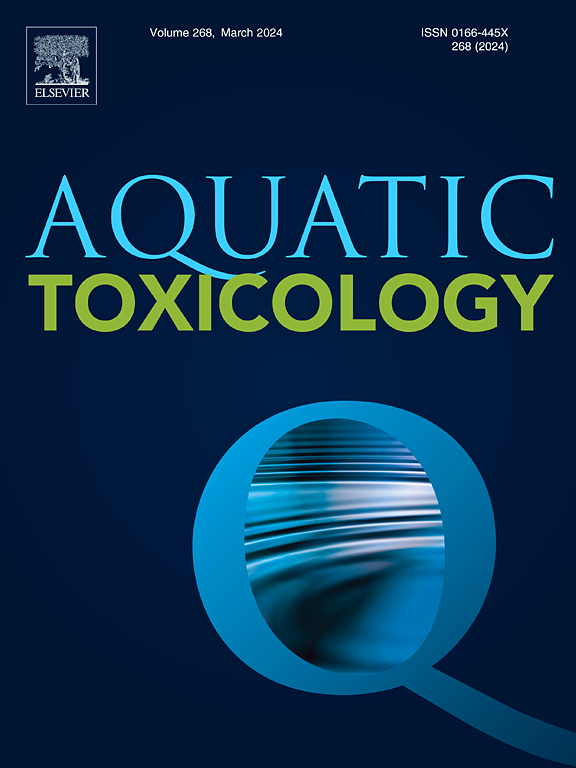利用可解释的结构参数建立预测模型来评估Gammarus物种中有机污染物的LC50
IF 4.1
2区 环境科学与生态学
Q1 MARINE & FRESHWATER BIOLOGY
引用次数: 0
摘要
该物种是环境健康的重要指标,对生态研究和水质评价具有重要意义。它们对有机化合物的中位致死浓度(LC50)提供了广泛的特定响应。本研究提出了四种预测模型,以确定影响Gammarus lacustris, Gammarus fasciatus, Gammarus pulex和Gammarus pseudolimnaeus的化学物质的LC50。这些物种因其对各种污染物的敏感性而被认为是最敏感的水生无脊椎动物之一。新模型提供了基于可解释的结构参数(包括有效官能团的数量、存在的原子类型和有机分子的各种结构特征)来估计各种有机化合物的pLC50(−log LC50/分子量)的直接方法。本研究的目的是利用最大的可用实验数据集,与之前的定量结构-活性关系(QSAR)模型相比,这些双足类动物。该数据集包含91种影响筋膜Gammarus fasciatus的化合物的毒性数据,50种影响湖泊Gammarus, 48种影响伪滨Gammarus和细尾Gammarus pulex,与比较QSAR模型一致。外部数据集包括13个fasciatus Gammarus化合物,2个湖泊Gammarus化合物和6个伪滨虾Gammarus化合物。努力的重点是使用有机化合物的可解释结构参数,而不是现有QSAR模型中概述的基于计算机的描述符。新模型与最佳QSAR模型的R²比分别为0.915/0.728、0.955/0.747、0.976/0.769和0.970/0.768。新模型中较高的R²值表明,在捕捉数据的潜在关系方面具有更高的可靠性和鲁棒性。本文章由计算机程序翻译,如有差异,请以英文原文为准。
Developing predictive models for assessing LC50 of organic contaminants in Gammarus species using interpretable structural parameters
Gammarus species are crucial indicators of environmental health, making them important for ecological studies and water quality assessments. They offer a wide range of specific responses regarding the median lethal concentration (LC50) of organic compounds. This research presents four predictive models to determine the LC50 of chemicals impacting selected gammarid amphipods: Gammarus lacustris, Gammarus fasciatus, Gammarus pulex, and Gammarus pseudolimnaeus. These species are recognized for their sensitivity to various pollutants and are among the most sensitive aquatic invertebrates. The new models provide straightforward methods for estimating the pLC50 (−log LC50/molecular weight) of various organic compounds based on interpretable structural parameters including the number of effective functional groups, the types of atoms present, and various structural characteristics of organic molecules. This study aims to leverage the largest available experimental dataset compared to prior quantitative structure–activity relationship (QSAR) models for these gammarid amphipods. The dataset contained toxicity data for 91 compounds affecting Gammarus fasciatus, 50 for Gammarus lacustris, and 48 each for Gammarus pseudolimnaeus and Gammarus pulex, aligning with comparative QSAR models. External datasets included 13 compounds for Gammarus fasciatus, 2 for Gammarus lacustris, and 6 for Gammarus pseudolimnaeus. Efforts focus on using interpretable structural parameters of organic compounds rather than computer-based descriptors, as outlined in the existing QSAR models. For the species G. fasciatus, G. lacustris, G. pseudolimnaeus, and G. pulex, the R² ratios for the new models versus the best QSAR models are 0.915/0.728, 0.955/0.747, 0.976/0.769, and 0.970/0.768, respectively. The higher R² values in the new models demonstrate greater reliability and robustness in capturing the data's underlying relationships.
求助全文
通过发布文献求助,成功后即可免费获取论文全文。
去求助
来源期刊

Aquatic Toxicology
环境科学-毒理学
CiteScore
7.10
自引率
4.40%
发文量
250
审稿时长
56 days
期刊介绍:
Aquatic Toxicology publishes significant contributions that increase the understanding of the impact of harmful substances (including natural and synthetic chemicals) on aquatic organisms and ecosystems.
Aquatic Toxicology considers both laboratory and field studies with a focus on marine/ freshwater environments. We strive to attract high quality original scientific papers, critical reviews and expert opinion papers in the following areas: Effects of harmful substances on molecular, cellular, sub-organismal, organismal, population, community, and ecosystem level; Toxic Mechanisms; Genetic disturbances, transgenerational effects, behavioral and adaptive responses; Impacts of harmful substances on structure, function of and services provided by aquatic ecosystems; Mixture toxicity assessment; Statistical approaches to predict exposure to and hazards of contaminants
The journal also considers manuscripts in other areas, such as the development of innovative concepts, approaches, and methodologies, which promote the wider application of toxicological datasets to the protection of aquatic environments and inform ecological risk assessments and decision making by relevant authorities.
 求助内容:
求助内容: 应助结果提醒方式:
应助结果提醒方式:


